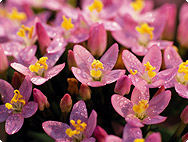
Centaurium erythraea RAFN.
Centaury

History
The name Centaurium is derived from the Greek
kentaúreion, the mythological creature with the head and torso of a man
on the body of a horse. The centaurs were held to be masters of
healing. According to Pliny, the centaur Chiron used this plant to
heal an arrow wound in his foot. The Romans called this bitter-tasting
plant Herba felis terrae, which means Gall of the Earth.
The species name minus is derived from the Latin minor meaning ’smaller‘ or ’lesser’.
The medicinal use of centaury can be traced back to the time of the Hippocratics (5th & 4th
centuries BC). Dioscorides recommended it as a purgative, emmenagogue
(to bring on menstruation) and for healing eyes and wounds.

Botanical characteristics
This annual or biennial herb sprouts from a light-coloured root and a basal leaf rosette. The upper portion of the four-edged, 20cm to 40cm high stalk is branched. The sparse lanceolate leaf pairs are crosswise opposite on the stalk. The small, pink, tubular flowers sit apically in several cymes. Centaury flowers from July to September.

Habitat
Centaury grows throughout Europe as far north as the Polar Circle, in North America, North Africa, and western Asia. It prefers moist forest clearings, roadsides, and mountain slopes at altitudes of up to 1400 metres.

Preparation
To manufacture an alcohol extract, A.Vogel/Bioforce uses the fresh above ground parts of the plant grown in organic cultivation. The herb is harvested when the plant flowers, from July to September. Centaury is often prepared as a tea.
A.Vogel Blog – Natural and Healthy
Inspiration for a healthy life!
HERBAMARE SOUP-ER SOUPS!
DOWNLOAD YOUR FREE RECIPE BOOKLET!
8 healthy, hearty and delicious homemade soups.
Supporting a healthier happier you
“Nature is just about the best thing we’ve got!“
Alfred Vogel's guide to leading a healthy and happy life
Healthy & nutritious dinner ideas
Get new recipes in your inbox every month. Sign up now